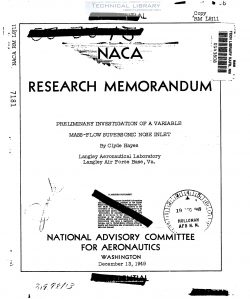naca-rm-l9j11
- Version
- 50 Downloads
- 494.67 KB File Size
- 1 File Count
- April 26, 2017 Create Date
- April 26, 2017 Last Updated
National Advisory Committee for Aeronautics, Research Memorandum - Preliminary Investigation of a Variable Mass Flow Supersonic Nose Inlet

A method has been analyzed for varying the mass flow of supersonic
inlets having a circular cross section and a central body. The method
consists of changing the size of the entering stream tube by means of
an inflatable boot on the surface of the central body. Tests were made
at a Mach number of 2.70 to determine the effect of such nose shapes on
the entering flow, mass flow, and pressure recovery. Comparison was
made between theoretical and experimental mass flows. The test results
show that the mass flow could be reduced to 76 percent of design mass
flow without a large loss of pressure recovery and without the unstable
flow conditions or discontinuities of the flow that exist in the fixed—
geometry diffusers when similar reductions in mass flow are made by
increasing the back pressure. Although drag measurements were not made
in this investigation, consideration of_shockswave configurations indicates
that the accompanying increase in drag is smaller than that caused by the
strong shock waves ahead of the inlet which usually accompany reductions
in mass flow made by increasing the back pressure.
From the performance characteristics of ram.3ets operating at
supersonic velocities.it can be shown that for effective operation over
a range of flight conditions, regulation of the mass flow is desirable.
For a fixed—geometry supersonic nose inlet of the type having a circular
cross section and a central body and having part internal and part
external supersonic compression, the mass flow cannot be reduced with
supersonic entering air. Theoretically it is possible to reduce the
mass flow by increasing the back pressure until the internal supersonic
compression is eliminated and a new flow condition is established.
This new flow condition is established suddenly and is accompanied by an
abrupt decrease of mass flow and an increase in drag. Figure 1 shows
the two flow conditions for a fixed—geometry inlet and illustrates the
asymmetrical flow condition which may exist due to uneven separation on
the central body. The result is asymmetrical loading of the inlet.
Since this flow condition is unstable, the mass flow cannot be reduced.
sufficiently without the flow oscillations and vibrations becoming of
such magnitude that this method cannot ordinarily be used. The mass
flow may also be regulated by moving the central body forward along the
axis of the inlet. Since the central body usually houses fuel,
instruments, and accessories, this system is sometimes not desirable.
| File | Action |
|---|---|
| naca-rm-l9j11 Preliminary Investigation of a Variable Mass Flow Supersonic Nose Inlet.pdf | Download |

Comment On This Post